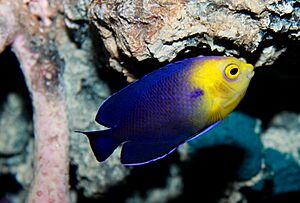Cherubfish facts for kids
Quick facts for kids Cherubfish |
|
|---|---|
 |
|
| Conservation status | |
| Scientific classification |
The cherubfish (Centropyge argi), also known as the pygmy angelfish, is a small, colorful fish that lives in the ocean. It's a type of marine angelfish and belongs to the Pomacanthidae family. You can find it in the western part of the Atlantic Ocean.
Contents
What Does the Cherubfish Look Like?
The cherubfish has a flat, oval body. It has a short nose and a small mouth. Near its gills, it has a strong spine with a jagged edge.
Its body is a deep blue color. Its head and chest are orange-yellow. It has a thin blue ring around its eye. There's also a small dark blue spot behind its mouth. Its pectoral fins (the ones on its sides) are light yellow. All its other fins are dark blue with light blue edges.
This fish has fins with both spines and soft rays. Its top fin (dorsal fin) has 14 to 15 spines and 15 to 16 soft rays. Its bottom fin (anal fin) has 3 spines and 17 soft rays. The cherubfish can grow up to 8 centimetres (3.1 in) long. That's about the size of your finger!
Where Do Cherubfish Live?
The cherubfish lives in the western Atlantic Ocean. You can find them near Bermuda. They also live from North Carolina all the way through the Caribbean Sea and the Gulf of Mexico. Their home extends to the Caribbean coast of South America, as far east as French Guiana.
Cherubfish Home and Habits
Cherubfish usually live in water that is 5 and 18 metres (16 and 59 ft) deep. Sometimes, they can be found even deeper, below 30 metres (98 ft). They like to live among broken coral pieces. There, they munch on algae (tiny water plants) and small creatures that live on the seafloor.
If they get scared, they quickly hide in small holes or cracks. Cherubfish often live in small groups of about 10 fish. These groups usually have one male, a few females, and some younger fish.
The Cherubfish Name
Scientists first officially described the cherubfish in 1951. The scientists were Loren Paul Woods and Robert H. Kanazawa. They found the first one near a place called Argus Bank in Bermuda. The fish's scientific name, argi, comes from this place.
Cherubfish as Pets
The cherubfish is a very popular fish for home aquariums. Many people love to keep them because of their beautiful colors and small size.


